Traveling should be fun, right? But honestly, pickpockets can ruin a trip faster than jet lag ever could. I remember standing in a packed Barcelona market, that little voice in my head whispering, “Wait, where’s my wallet?” If you want to avoid pickpockets while traveling, you’ve got to stay alert, keep your valuables close—preferably in anti-theft bags—and try not to scream “tourist” with your outfit or behavior.
Pickpockets target distracted travelers in crowded places like train stations, tourist sites, and markets. They’re always on the lookout for easy marks—people fumbling with maps, carrying backpacks loosely, or showing off expensive gadgets.
Blend in with locals as much as possible. Keep your head up and scan the crowd around you, and you’ll signal that you’re not an easy target.
Key Takeaways
- Stay alert in crowds, and keep your valuables in front pockets or anti-theft bags close to your body.
- Dress simply and stay aware of your surroundings so you don’t stand out as a tourist.
- Use cards instead of cash when you can, and have a backup plan with digital copies of important documents.
Understanding Pickpockets

Pickpockets use specific strategies and love predictable locations where travelers let their guard down. If you know how they work, you’ve already got an edge.
Common Techniques Used by Pickpockets
Pickpockets almost never work solo. Usually, one distracts you while another goes for your stuff. The classic “bump and grab” is one of their favorites—someone bumps into you, says sorry, and meanwhile, their partner’s already swiped your wallet.
The “helpful stranger” trick is another. Someone points out a fake stain on your shirt and offers to help clean it. Next thing you know, your pockets are empty.
Some thieves use props—newspapers, maps—held over your bag or pocket while their hands work underneath. Others create fake crowds at tourist sites or on the subway to get close enough to steal.
Watch out for sudden commotions too. These often get staged to grab your attention while someone else picks your pocket.
High-Risk Locations and Situations
Tourist attractions are basically pickpocket hotspots. The Eiffel Tower, Roman Colosseum, Barcelona’s Las Ramblas—you name it, someone’s probably had their wallet lifted there.
Public transportation is especially sketchy. Crowded buses, subways, and train stations give thieves plenty of cover and quick exits.
Busy markets and shopping streets attract pickpockets because people are distracted and often have their wallets out.
Restaurant patios and outdoor cafés can be risky too. Hang your bag on your chair, and it becomes an easy target.
ATMs are danger zones. You’re focused on the screen, pulling out cash, and not watching your surroundings. Festivals and nightlife spots? Also risky—especially if you’ve let your guard down.
How Pickpockets Target Travelers
Pickpockets spot tourists a mile away—maps, cameras, confused expressions, you get the idea. If you keep checking your pocket, you’re basically telling them where your valuables are.
They target people who seem distracted or overwhelmed. If you’re walking while glued to your phone, you’re making it easy for them.
Pickpockets pay attention to body language and look for signs of wealth—like expensive watches, designer bags, or flashy jewelry. They prefer people who aren’t paying attention.
They know travelers often carry more cash than locals and might not report crimes because of language barriers or tight schedules.
They especially watch for people reading “Beware of Pickpockets” signs. Most folks instinctively touch their valuables, revealing exactly where they’re hidden.
Essential Prevention Tips
Protecting yourself from pickpockets takes a mix of smart prep and constant awareness. Here are some practical strategies to help you keep your stuff safe and actually enjoy your trip.
Securing Your Belongings
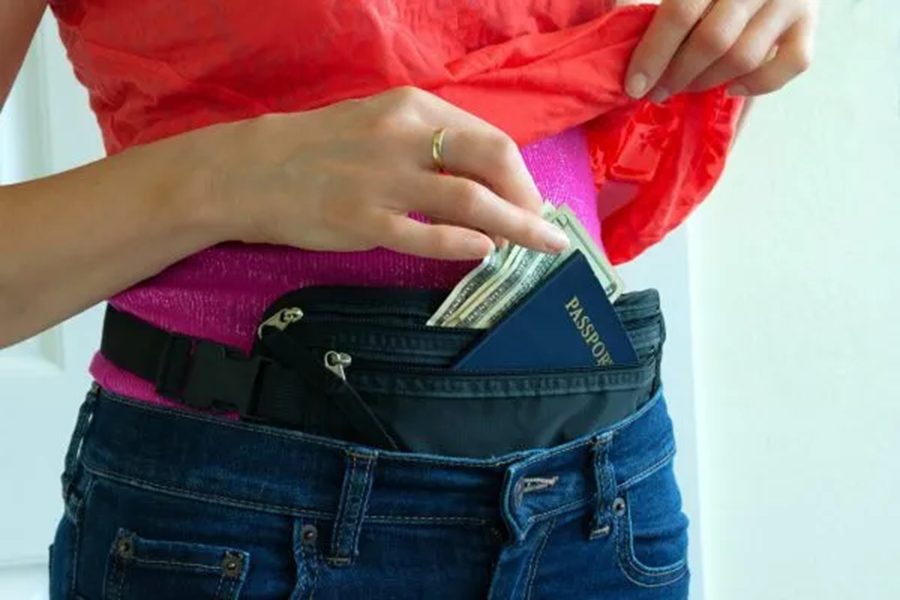
Don’t put all your valuables in one spot. Split up your cash, cards, and documents between different secure places on your body and in your luggage.
A money belt under your clothes works wonders. Keep your passport, extra cash, and credit cards tucked safely against your body. Just don’t pull it out in public—that defeats the point!
Front pockets are safer than back ones for things you need to reach. Try wrapping a rubber band around your wallet for extra friction—it’s a simple trick, but it helps.
Use hotel safes for extra cash, your passport (carry a copy instead), and jewelry you won’t need that day.
Choosing Anti-Theft Travel Gear
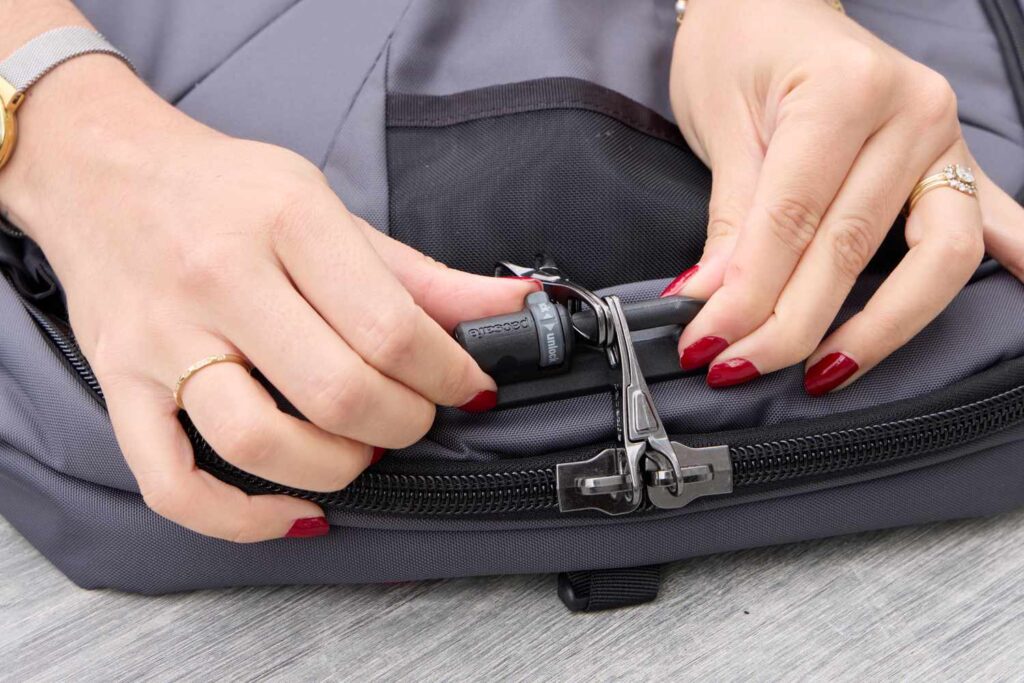
Go for bags designed to stop pickpockets. Look for stuff like:
- Hidden zippers and pockets
- Slash-proof straps and materials
- RFID-blocking tech to stop electronic theft
- Zippers that lock
Wear backpacks on your front in crowded places, or use cross-body bags you can always see. Keep the bag in front, not behind or at your side.
Try travel clothes with hidden pockets—shirts, pants, even underwear with zippered compartments. Super handy for stashing cards or cash.
Phone leashes that attach your device to your bag or belt can save you from those quick snatch-and-grab thefts.
Maintaining Awareness in Crowded Areas
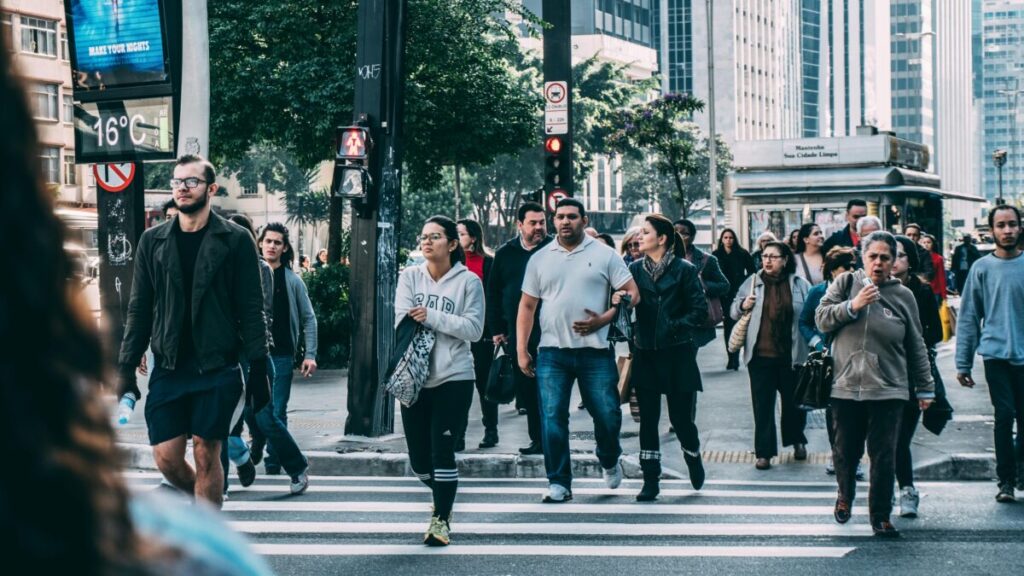
Stay sharp in places known for pickpocketing: subways, tourist attractions, markets, and busy shopping streets. Thieves often work in teams—one distracts, the other steals.
When you spot a “Beware of Pickpockets” sign, resist the urge to check your pockets! That’s exactly what thieves want.
Stay alert when:
- Someone bumps into you
- There’s a sudden commotion
- People ask for directions with maps
- You notice a spill or mess on your clothes
Trust your gut. If someone’s standing too close or something feels off, move away and check your stuff.
Blending In With Locals
Looking like a tourist is an open invitation. Check out local dress codes and pack accordingly. Leave the fanny pack and logo gear at home unless everyone else is wearing them.
Walk with purpose, even if you’re lost. Step into a shop or café to check your map instead of standing confused on the sidewalk.
Keep your fancy camera and phone stashed when not in use. That $1000 phone is a magnet for thieves if you wave it around.
Learn a few local phrases. Even just “no thank you” can make you look more like a resident. Pickpockets target people who seem lost or can’t communicate.
Travel Habits That Reduce Risk
Smart travel habits are your best defense. Small changes in how you carry and store your stuff can make a huge difference.
Limiting What You Carry
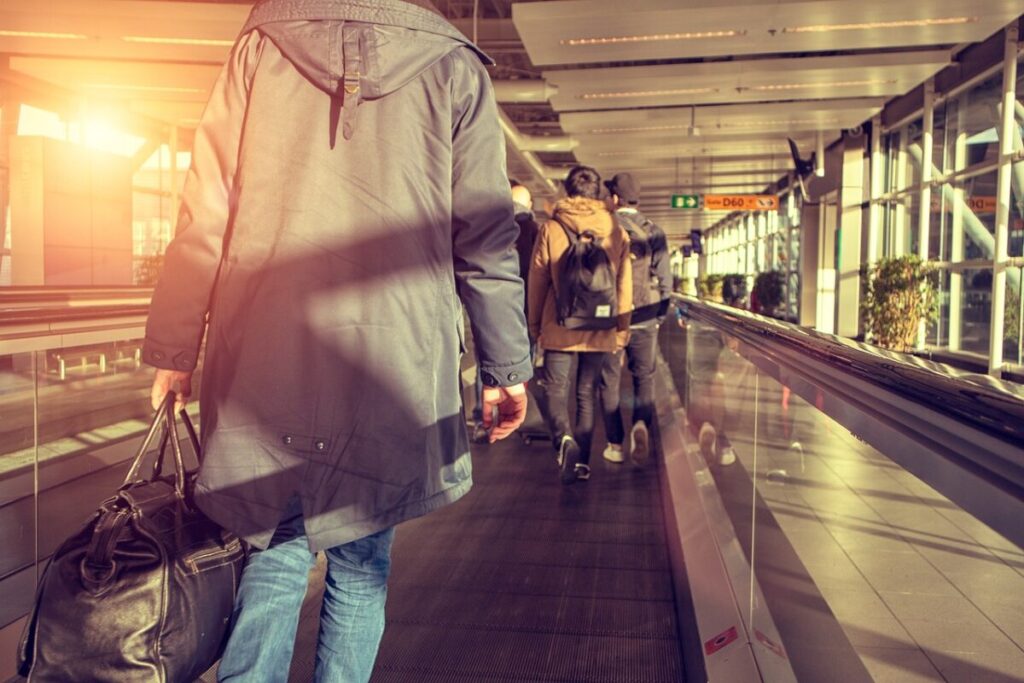
Leave valuables at home if you can. Do you really need three credit cards for a day out? Probably not. Take just what you need—one card, a little cash, maybe your ID or a passport copy.
Before heading out, clean out your wallet. Get rid of loyalty cards, receipts, and anything else you’d hate to lose.
Some travelers carry a dummy wallet with a bit of cash to hand over if mugged. Sounds extreme, but it beats losing everything.
When sightseeing, stash expensive jewelry and designer items in your hotel safe. Flashy stuff just says, “Rob me!”
Dividing Valuables
Don’t keep all your money and cards together. If your wallet vanishes, you don’t want to be stranded.
Split your cash between different pockets or bags. I sometimes tuck emergency money in a sock or shoe when I’m in pickpocket-prone areas.
If you’re traveling with someone, divide important items between you. If one bag goes missing, you’re not out of luck.
Try a “daily allowance” system—carry just what you need for the day and keep the rest locked up.
Keep a backup credit card and some cash in a separate spot from your main wallet. It’s a small thing, but it brings peace of mind.
Using Hidden Pouches and Money Belts
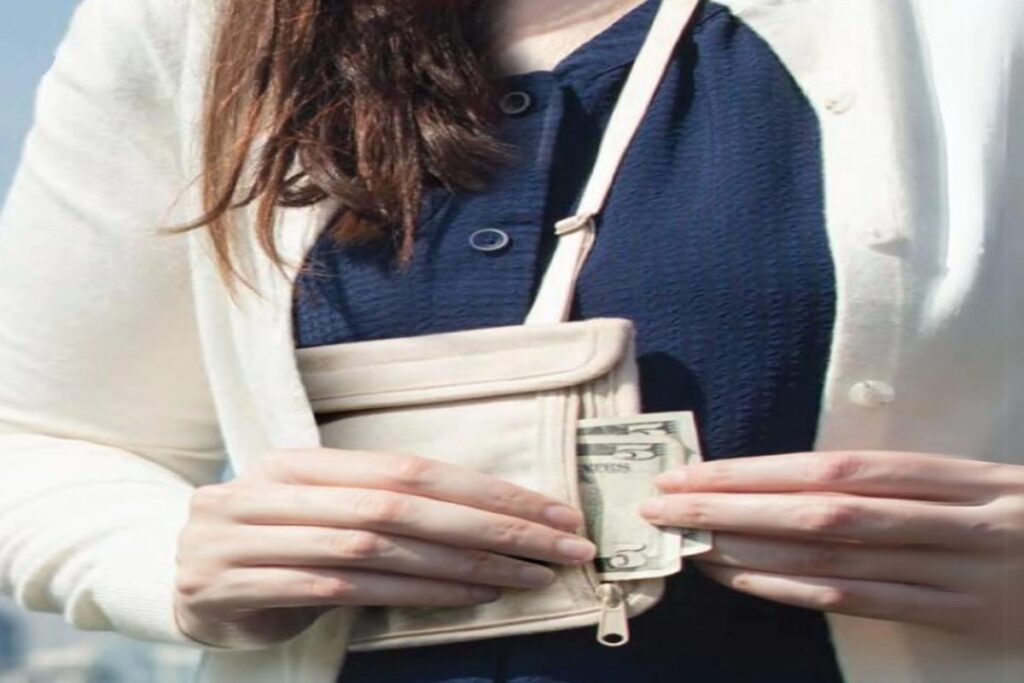
Money belts are a traveler’s secret weapon. Worn under your clothes, they keep valuables close and out of reach.
Types of anti-theft gear:
- Under-clothing money belts
- Neck pouches inside your shirt
- Leg wallets strapped to your calf
- Bra pouches
- Belt wallets hidden in the buckle
Don’t access your money belt in public. Duck into a bathroom or private corner if you need something. Thieves watch for people revealing their “hidden” stashes.
Some travel clothes have zippered hidden pockets—these look normal but are great for cards or keys.
Pickpockets know about money belts, so use them wisely. Keep them hidden, and don’t keep fiddling with them.
Smart Wallet and Bag Strategies
How you carry your stuff can be the difference between a great trip and a disaster. The right wallet and bag setup is your best defense against pickpockets.
Carrying Bags in Front
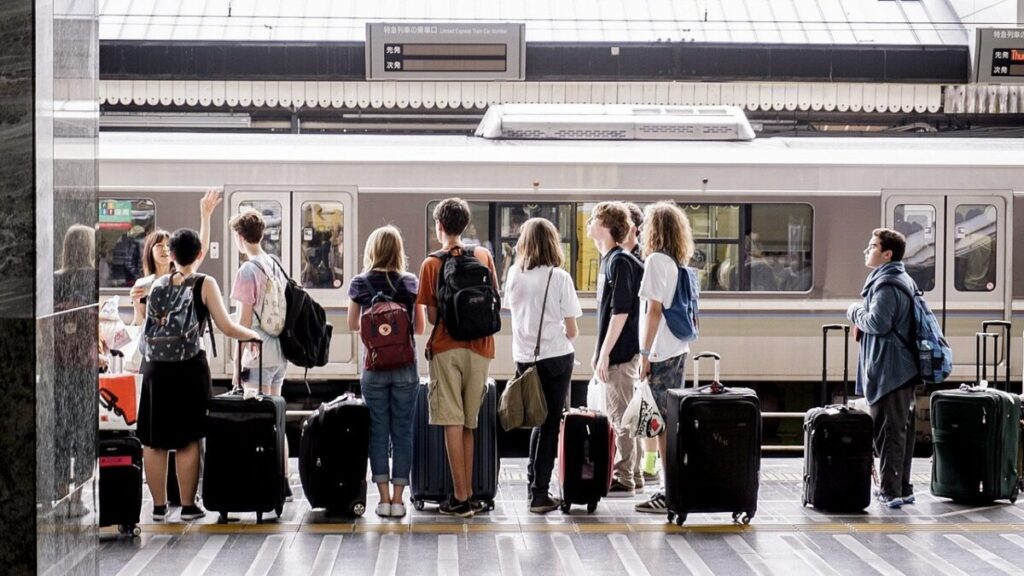
Keep your bag where you can see it. In crowded places, swing your backpack to your chest. It’s a small move, but it makes it way harder for thieves to get in.
Cross-body bags beat shoulder bags—they’re harder to snatch. Wear them high and tight, with the bag in front.
When you’re sightseeing, keep a hand on your bag strap in crowds. It’s a physical barrier and a signal that you’re paying attention.
I prefer bags with internal compartments. Stash your passport and extra cash in the inner pockets, not the outer ones.
Choosing Secure Closures
Zippers are your friend—way more secure than snaps or open tops. Look for bags with double zippers you can lock together with a tiny padlock.
Anti-theft bags have hidden or lockable zippers and sometimes even slash-proof straps and fabric.
Avoid bags with easy-access outer pockets. If you have them, only use them for things you don’t mind losing, like a map or water bottle.
When you eat out, don’t hang your bag on your chair. Keep it on your lap or between your feet with the strap looped around your leg.
Pickpockets want easy targets. Even simple security features can make them move on.
Avoiding Back Pockets
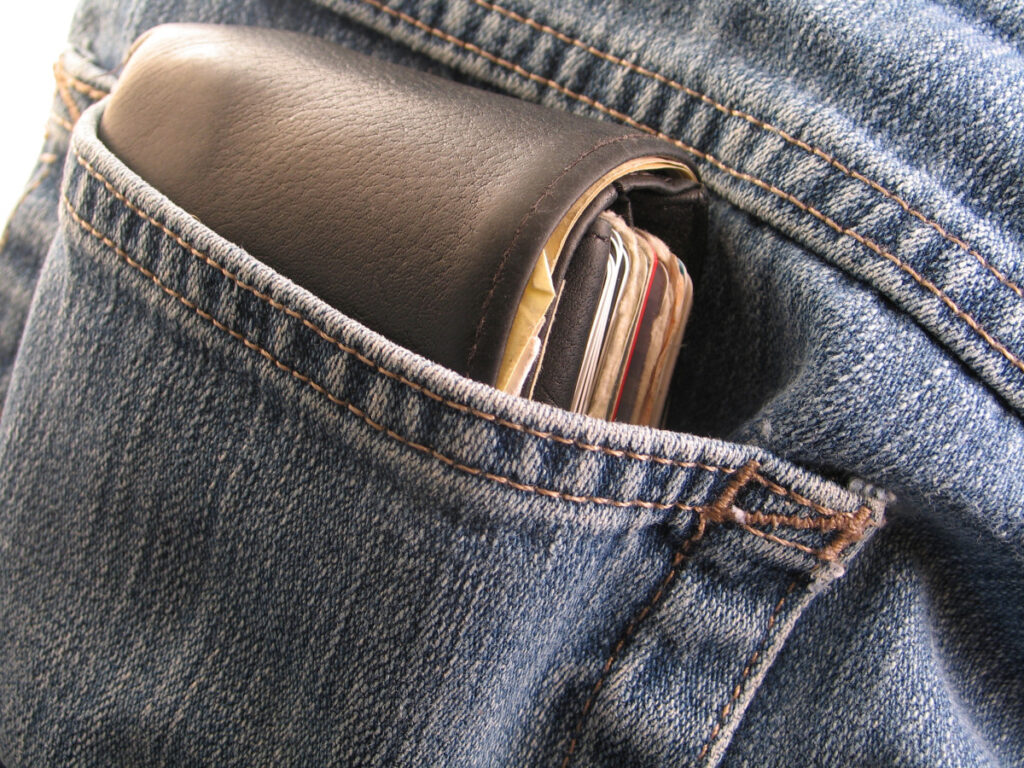
Don’t ever put valuables in your back pockets. That’s pickpocket central—they’re easy to reach and you won’t notice a thing.
Front pockets are better, especially if they have zippers or buttons. Pants with hidden security pockets are even better for travel.
Money belts under your clothes keep essentials totally out of reach. They’re slim and hold your passport, cash, and cards.
If you use a regular wallet, keep it slim—just the basics for the day. Bulky wallets show through your pocket and attract attention.
I started using a small wallet attached to an inner loop in my pants with a short chain. It’s simple, but I feel way more secure in busy places.
Reacting to Suspicious Behavior
Staying sharp while traveling means knowing what to do when something feels off. Your instincts are usually your best defense.
Recognizing Pickpocket Distractions
Pickpockets love distractions. They’ll try all sorts of tricks to get your attention off your stuff. Watch for these:
- Someone “accidentally” bumps into you
- Groups of kids surround you with newspapers or maps
- Sudden arguments or fights break out nearby
- Someone spills something on you
- Strangers ask for directions while standing way too close
If you notice any of these, check your belongings and put some space between you and the suspicious person. Don’t feel like you have to help everyone who approaches.
Trust your gut. If something feels off, it probably is. I almost fell for the “bird poop on your shoulder” trick in Barcelona, but recognized it just in time and walked away with everything intact.
Protecting Yourself in a Crowd
Crowded spots—subways, tourist sites, markets—are pickpocket heaven. Here’s how to stay safe:
- Move valuables to front or inside pockets before entering crowds.
- Keep your bag in front of you, with zippers facing your body.
- Stay alert when someone gets in your personal space.
Don’t pull out your phone, wallet, or map in busy areas if you can help it. Step into a store or quiet spot if you need to check something.
If someone seems to be following you or paying too much attention to your stuff, duck into a shop or restaurant. Change your route if you need to. Most pickpockets will give up if they know you’ve noticed them.
Practical Steps After a Theft
Even with all the precautions, sometimes things go sideways. If you get pickpocketed, acting fast can limit the damage and get you back to enjoying your trip.
Reporting to Local Authorities
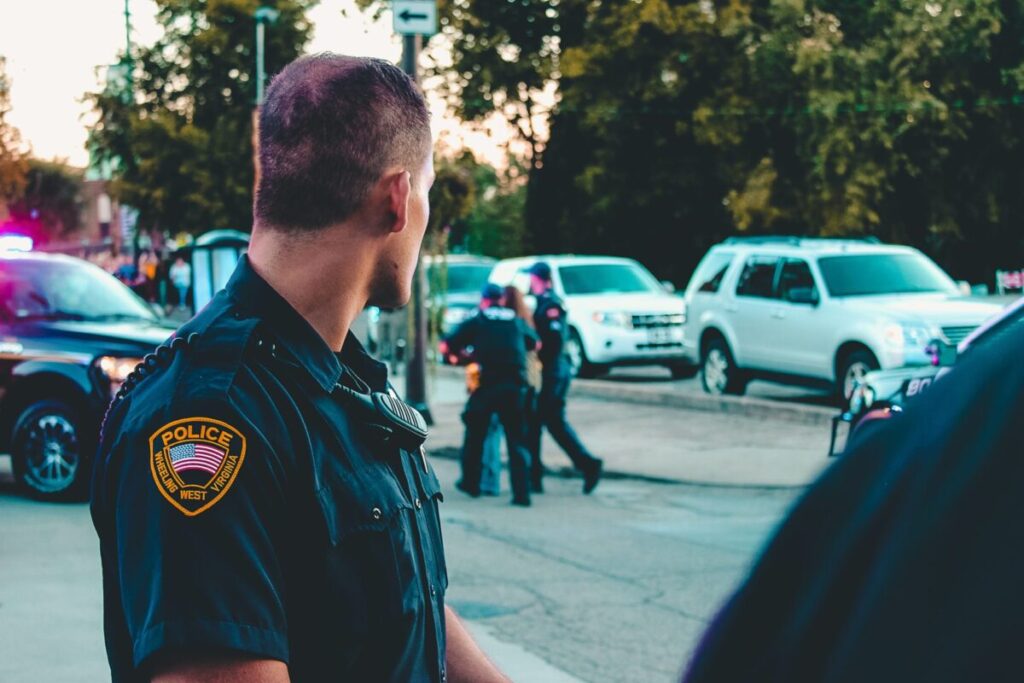
File a police report as soon as you can. Head to the nearest police station, or ask your hotel staff for help if you’re not sure where to go.
Bring a copy of your passport—hopefully you kept it separate from the stolen one—to prove your identity. In most touristy areas, you’ll find officers who speak English, but if you’re struggling, just ask for a translator.
Be clear about what was taken and where it happened. Jot down the officer’s name and make sure you get a copy of the report; you’ll need that for any insurance claims later.
Some cities have special tourist police units, and they’re usually more used to dealing with travelers. These officers can offer extra guidance and might make the process a bit smoother.
Canceling Credit Cards and Documents

Move quickly to cancel your stolen cards. Most banks offer 24-hour emergency numbers for lost or stolen cards—hopefully you saved these somewhere safe, like your email or with a friend.
Make a quick list of everything that was in your wallet or bag. Call your credit card companies first, since those pose the biggest risk.
If you lost your passport, get in touch with your country’s nearest embassy or consulate right away. They’ll issue emergency travel documents, but you’ll need to prove who you are. Having a digital passport copy in your email can really speed things up.
Don’t forget about your driver’s license, health insurance card, or travel insurance documents. Reach out to each issuer for replacements.
Accessing Emergency Assistance
Your travel insurance is your lifeline after a theft—call them right away. They can often advance emergency funds, help replace documents, cover hotel costs if you’re stranded, and even help with translation at the police station.
Hotels usually do their best to help guests who’ve been robbed. Sometimes they’ll offer a small loan, make calls for you, or point you toward the right embassy.
If you’ve got no money left at all, contact your country’s embassy. They can help you get in touch with family for a money transfer. Some credit card companies offer emergency cash advances too, even after you’ve canceled the card.
Apps like WhatsApp or Messenger are a godsend for reaching family quickly when you need help.
Travel Insurance for Theft Protection

Travel insurance can be a real safety net if you get unlucky and fall victim to pickpockets or thieves. Even if you do everything right, theft can still happen—having the right coverage makes bouncing back much easier.
Choosing the Right Coverage
When you’re shopping for travel insurance, check that the policy covers personal belongings and theft. Not every plan does! Some bare-bones options might only cover medical stuff, leaving your valuables out in the cold.
Look for these features in your policy:
- Personal belongings coverage with limits that actually cover your stuff
- Electronics coverage (some policies leave out smartphones or laptops)
- Cash coverage (usually a small amount, but better than nothing)
- Reasonable deductibles so it’s actually worth making a claim
Some premium credit cards include theft protection if you use them to book your trip. Check your card’s benefits before you buy extra insurance.
Read the fine print about exclusions. Most policies refuse to pay out if you left something unattended or in an unlocked room.
Filing a Claim After Theft
If someone steals your stuff, act fast—it helps your chances with insurance. Report the theft to local police right away. Insurance companies always want to see a police report.
Document everything about the stolen items. Take photos of similar things if you have them, note serial numbers, and keep receipts somewhere safe. Digital copies of important documents can save you a ton of hassle.
Contact your insurance company as soon as you can. Most have 24-hour hotlines for travelers and will walk you through the claim process.
Hang onto receipts for any emergency purchases you make to replace essentials. Many policies will reimburse these costs while you’re still on your trip.
Tips for Specific Destinations
Every destination has its own pickpocket tricks and hotspots. Knowing where thieves operate and what to watch for can keep you a step ahead.
Urban Environments

Big cities like Barcelona, Rome, and Paris are notorious for pickpockets. In Barcelona, watch out on Las Ramblas—thieves often work in teams, one distracts while another grabs your stuff. Around Rome’s Colosseum and Termini Station, keep your guard up.
Walk with purpose. If you look lost, you become a target. If you need to check your phone for directions, duck into a shop instead of standing on the street.
Markets are prime spots for thieves. In Istanbul’s Grand Bazaar or London’s Camden Market, wear your backpack on your front or use a cross-body bag with the zipper facing your body.
Outdoor cafés can be risky. Never hang your bag on a chair or leave your phone on the table. Keep valuables in your lap or between your feet.
Public Transportation Systems

Subways and buses are paradise for pickpockets. In Paris, Metro line 1 is especially bad. In Barcelona, thieves target Line 3, especially toward Park Güell.
During rush hour, be on high alert. That “accidental” bump? It’s probably not an accident.
On overnight trains, sleep with your valuables in a money belt. Lock your compartment door if you can.
Taxis might not be as safe as you’d hope. In some places, drivers work with pickpockets. Stick to official taxi stands and check that the taxi is legit before you get in.
Bus stations in Prague and Amsterdam are known trouble spots. Keep your bag in front of you and don’t set anything down, even for a second.
Tourist Attractions

The Eiffel Tower, Vatican City, and the Taj Mahal all attract thieves. At the Louvre, watch out for “petition scammers”—while you’re distracted, an accomplice might dip into your pockets.
Popular viewpoints are perfect for thieves. While you snap photos at Prague Castle or Athens’ Acropolis, someone could be eyeing your bag.
Lines are dangerous too. In the Vatican Museum queue, keep your bag zipped and in front of you. Use a money belt for your passport and most of your cash.
Street performers often have pickpocket partners. In London’s Covent Garden or Times Square, enjoy the show but keep a hand on your stuff.
Beaches in places like Rio or Barcelona are theft magnets. Never leave your bag unattended while swimming. Waterproof pouches for your essentials can be a lifesaver.
Staying Safe When Using Technology
Traveling with tech is just part of life now, but it opens up new risks. Protecting your devices and digital info takes a bit of planning, but it’s totally worth it.
Mobile Phone Security
Your phone is probably your most valuable travel buddy these days—and it’s a prime target. Never leave your phone sitting out in public, even for a second. Café tables are especially risky when you’re distracted.
Keep your phone in a front pocket or a cross-body bag with a zipper. Back pockets? Just don’t. Consider using a phone leash or wrist strap for extra peace of mind when taking photos in crowds.
When you’re not using your phone, stash it out of sight. Thieves love tourists who walk around with phones in hand. Set up tracking features like Find My iPhone or Find My Device before you leave. Use screen locks with strong passwords or biometrics.
Protecting Digital Wallets

Digital wallets like Apple Pay and Google Pay can be safer than cash, but you still need to protect them. Always turn on two-factor authentication for your payment apps before your trip. That extra step makes a big difference if someone grabs your phone.
Be discreet when using digital payments in public. Shield your screen when entering PINs or passwords. Try to use mobile payments with reputable shops, not sketchy vendors.
Make copies of important cards and IDs. Store digital versions in a secure, encrypted app, and keep physical copies separate from the originals. An RFID-blocking wallet or pouch can help protect your cards from electronic theft.
Turn off Bluetooth and WiFi when you’re not using them. Public WiFi is convenient, sure, but risky—use a VPN or your phone’s hotspot if you can.
Frequently Asked Questions
Travelers face all sorts of challenges, and pickpocketing is one of the most common annoyances. Here are some practical tips to help you keep your stuff safe.
What are the most effective ways to keep your belongings safe from pickpockets during your travels?
A money belt under your clothes is one of the best defenses. It keeps essentials like your passport, backup cash, and credit cards hidden and close.
Don’t keep all your valuables in one spot. Split up your money and cards between different pockets and bags. If you do get hit, you won’t lose everything.
Stay aware of your surroundings, especially in crowds. Pickpockets love distractions, so be extra careful if someone bumps you or causes a scene nearby.
Could you offer guidance on the best types of bags or accessories that help deter pickpockets?
Cross-body bags beat shoulder bags every time—they’re harder to snatch and stay close to you. Look for thick, slash-resistant straps.
Bags with anti-theft features like locking zippers, slash-proof material, and RFID protection are worth the investment. They’ll save you a lot of stress down the line.
Avoid backpacks in high-risk areas since you can’t see what’s going on behind you. If you have to use one, wear it on your front in crowds or stash valuables in inner pockets.
Are there specific strategies one should adopt to prevent pickpocketing in crowded tourist areas?
Stay extra vigilant at tourist attractions, on public transit, and in busy markets. These are prime spots for thieves hunting for distracted travelers.
When you spot “Beware of Pickpockets” signs, don’t instinctively check your valuables. Thieves sometimes use those signs to see where people keep their wallets.
Keep some space between you and others whenever you can. If someone gets too close or tries to distract you, be suspicious—it could be the setup for a theft.
What clothing options can increase your protection against pickpockets?
Pants or jackets with hidden zippered pockets work wonders. These keep valuables close and make it tough for thieves to get at them without you noticing.
Never keep anything valuable in back pockets or outer jacket pockets. Those are the easiest targets for quick-fingered thieves.
Travel clothing with built-in security features is a thing now—some brands make stylish options with hidden compartments and secure pockets just for travelers.
In what ways can a traveler outwit pickpockets and safeguard their valuables?
Leave anything you don’t need for the day in your hotel safe. Carry just the essentials, and keep copies of important documents separate from the originals.
Mix up where you stash your stuff. Thieves expect wallets in back pockets or money in purses, so consider using an inner jacket pocket or some other less obvious spot.
Stay sober and alert. Thieves prefer to target people who look intoxicated or distracted—they’re just easier victims.
What actions should you take if you suspect someone is trying to pickpocket you?
If you feel like someone might be eyeing your stuff, just move away—get to a less crowded spot or duck into a nearby shop. Seriously, putting some space between you and anyone sketchy should be your top priority.
Find a moment to check your belongings, but try to do it somewhere safe and out of sight. If you notice something’s gone, go to the local police right away and let them know.
Listen to your gut. If someone gives you a weird vibe or acts oddly, forget about being overly polite. Honestly, your safety matters way more than worrying about social rules.

Leave a Reply